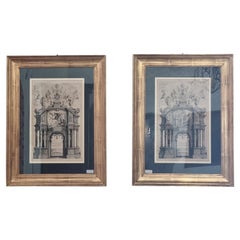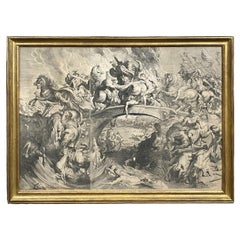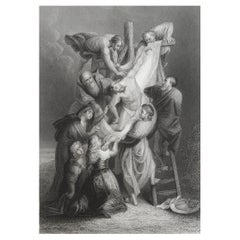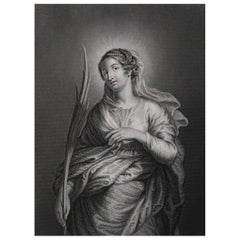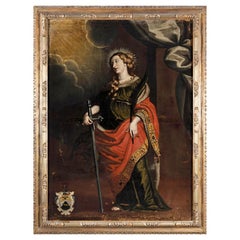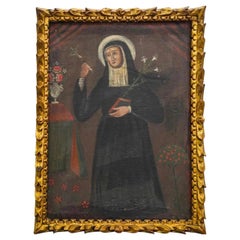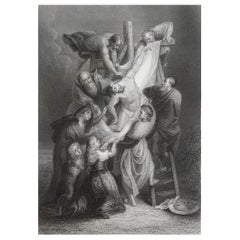Peter Paul Rubens
Flemish, 1577-1640
Peter Paul Rubens was a Flemish painter and one of the most influential artists of the Baroque period. Born in Siegen, Germany, he grew up in Antwerp, where he trained as a painter. He traveled to Italy and Spain, studying Renaissance masters like Titian, Caravaggio, and Michelangelo, which greatly influenced his dynamic and dramatic style.
Rubens became famous for his large-scale, energetic compositions filled with movement, rich colors, and emotional intensity. His works often depicted religious, mythological, and historical themes. Among his most famous paintings are The Descent from the Cross, The Garden of Love, and The Consequences of War.
Aside from painting, Rubens was also a diplomat, working for European courts and nobility. His workshop in Antwerp produced numerous masterpieces with the help of talented assistants, including Anthony van Dyck.
He died in 1640 in Antwerp, leaving behind a vast artistic legacy that continues to inspire generations.to
1
4
1
5
3
3
2
4
1
5
2
2
2
1
5
5
5
5
7,546
3,967
2,548
2,244
Creator: Peter Paul Rubens
17th Century Pair of Etchings by Theodoor Van Thunlden from Rubens, Antwerp 1642
By Theodoor van Thulden, Peter Paul Rubens
Located in Cagliari, IT
"Arch dedicated to Hercules" and "Arch dedicated to Bellerophon"
Splendid and very rare etchings belonging to a suite of subjects executed for the preparations of the "Celebrations for the entry into Antwerp of the Cardinal-Infante Ferdinando of Habsburg-Spain on 17 April 1635".
The sketches for the decorations were all drawn by Sir Peter Paul Rubens and the execution of the etchings was entrusted to Van Thulden.
Bottom left: P.P. Rubens. Bottom right: G. Gervatius (who was commissioned to bring together the illustrations of the arches in a special volume) and Van Thulden.
Laid paper with watermark - copper imprint - margins - excellent condition.
At the end of 1634 Peter Paul Rubens (1577-1640) was invited to make a series of drawings to decorate the city of Antwerp on the occasion of the solemn entry of the infant cardinal Ferdinand of Habsburg (1609-1641) who, after his death of Archduchess Isabella Clara Eugenia (1633), Spanish governor of the southern Netherlands, had been elected as his successor. Generally in these circumstances, the itinerary was articulated through a series of stations and the city - in its main urban hubs - was adorned with decorations and ephemeral apparatuses which, without solution of continuity, covered the facades of the palaces, churches and convents facing the parade axis of the celebratory itinerary, testifying to the participatory role of the various public and private institutions that took part in the feast1. As had happened for the entrances of Charles V in 1520, of Philip II in 1549 and of the archdukes Albert and Isabella in 1599, also in this case, on 17 April 1635, the most important streets and squares of Antwerp were enriched with arrangements: temporary altars, four scenarios, a portico and large triumphal arches built in wood, over twenty meters height, decorated with paintings, sculptures and allegorical scenes. The references to the ancient alluded in this case to the greatness of the Habsburgs and to the merits of Ferdinand for the victory obtained over the Protestant armies of Sweden and their German allies. The choice to use the triumphal arch has its roots in the "city of the popes" and must be read as a connection with the triumphal and modern arches, with Rome and with the "possession" ceremony, placing the emphasis on its centuries-old use . In the elaboration of the drawings and sketches Rubens proved to be a true connoisseur of architecture, but what is most surprising about the artist is the casual use of architectural language and fidelity to sixteenth-century Roman models. In order for the memory of these works to be perpetuated over time, some artists were commissioned to etch the ephemeral apparatuses and, under the guidance of the painter Theodor van Thulden...
Category
17th Century Belgian Baroque Antique Peter Paul Rubens
Materials
Paper
Peter Paul Rubens Six Plate Engraving, The Battle of the Amazons
By Peter Paul Rubens
Located in Milford, NH
A fine example of a large engraving assembled from six printing plates, by well known German artist Peter Paul Rubens (1577-1640). Rubens was born in Siegen, Westphalia, Germany and ...
Category
17th Century Belgian Antique Peter Paul Rubens
Materials
Paper
Original Antique Print After Rubens, Jesus Christ Descent from the Cross, C.1850
By Peter Paul Rubens
Located in St Annes, Lancashire
Wonderful image after Rubens
Fine steel engraving.
Published by Sangster, C.1850
Unframed.
Category
1850s English Renaissance Antique Peter Paul Rubens
Materials
Paper
Antique Print of St Catherine. After Rubens. C.1850
By Peter Paul Rubens
Located in St Annes, Lancashire
Wonderful image after Rubens
Fine Steel engraving.
Published C.1850
Unframed.
Category
1850s English Baroque Antique Peter Paul Rubens
Materials
Paper
Peter Paul Rubens Circle of "Saint Catherine " Never Restored First Canvas
By Peter Paul Rubens
Located in Madrid, ES
Peter Paul Rubens (Siegen 1577 - Antwerp 1640) circle of
Saint Catherine of Alexandria
Never Restored First Canvas
Oil on canvas
129.5 x 94 cm
The work is based on the painting by Peter Paul Rubens and engraved by Schelte von Bolswert.
Rubens, known as "the Prince of the Baroque", was the great master who revolutionized both Flemish and European painting. His first training took place thanks to the masters Otto van Veen and Jan Brueghel the Elder. His trip to Italy, where he stayed, studied and painted for eight years, was fundamental to his artistic growth. His first stop was Venice, where Titian, Veronese and Tintoretto studied. He later came into contact with Vincenzo I Gonzaga, Duke of Mantua, becoming the court painter of the family, a position he held until the end of his stay in Italy. In Mantua, Rubens had the opportunity to study the rich ducal collection closely and assiduously. By making copies of several famous paintings he was able to practice technically on the examples of the greatest masters. In 1601 he was sent by the duke to Rome, where he was able to further broaden his figurative horizons thanks to the copying of the models of Michelangelo and Raphael and the study of the ancient, also looking at the contemporary artistic production of Carracci, Caravaggio and Federico Barocci. After leaving Italy, he settled in Antwerp, where he organized his atelier, applying the methods of organized production, that is, employing his collaborators with rational criteria and on the basis of individual specializations. Among the many painters who came out of Rubens' workshop or were strongly influenced by the master, we remember: Cornelis and Paul de Vos, Jacob Jordaens, Pieter Van Mol, Victor Wolvoet, Joanna Vergouwen, Jan Boeckhorst known as Lange Jan, Lucas Van Uden, Theodor Van Thulden, Peter Van Lint, Willem Van Harp, Vincent Adrianssen, Pieter Van Avont, Jan and Hendrick van Balen, Theodor Boeyemans or Boeijermans, Vincent Malò...
Category
17th Century German Baroque Antique Peter Paul Rubens
Materials
Paint
Related Items
Saint Catherine Of Sienna Oil On Canvas Spanish Colonial Painting
Located in Bradenton, FL
18th Century oil on canvas painting depicting Saint Catherine of Siena bearing lilies and a book in her left hand and a crucifix in her right ...
Category
18th Century Italian Baroque Antique Peter Paul Rubens
Materials
Canvas, Wood
19 Century English Portrait of an Aristocratic Gentleman in the Manner of Rubens
By Peter Paul Rubens
Located in Vancouver, British Columbia
A 19th C three quarter length portrait of an aristocratic gentleman with his personal valet shown behind him. The young man with flowing long hair is portrayed from the waist up and ...
Category
Mid-19th Century English Renaissance Antique Peter Paul Rubens
Materials
Canvas
H 44 in W 35 in D 2 in
Pierre Paul Rubens « Silène’s Walk », Engraving 18th Century
Located in Beuzevillette, FR
Beautiful engraving made by Nicolas de Launay after the work of Peter Paul Rubens.This engraving represents a bacchanalian scene featuring Silenus a mythological character.
In this...
Category
18th Century French Antique Peter Paul Rubens
Materials
Paper
KPM Style Plaque of Saint Catherine of Alexandria
Located in Guaynabo, PR
This is a KPM style hand painted plaque of Saint Catherine of Alexandria. The bright colors of her robes highlight her porcelain skin. Sh...
Category
Early 20th Century Unknown Renaissance Revival Peter Paul Rubens
Materials
Porcelain
Peter Paul Rubens Brass Wall Plaque
Located in West Palm Beach, FL
Round brass wall plaque of the Flemish master, Peter Paul Rubens.
Category
Early 20th Century Belgian Peter Paul Rubens
Materials
Brass
Antique Costume Print of a Woman with Child, from Egypt, 1850
Located in Langweer, NL
Antique costume print titled 'Femme du Peuple (Egypte)'. Old print depicting a woman from Egypt. This print originates from 'Costumes Moderne (Musée de Costumes). Published in Paris:...
Category
Mid-19th Century Antique Peter Paul Rubens
Materials
Paper
B.West Engraving "Naval Battle, Battle of the Houge" 18th Century
Located in Beuzevillette, FR
This magnificent engraving is entitled "Battle of La Hougue" by the engraver E.C Voysard after Benjamin West.
It depicts the Battle of Barfleur- La Hougue,...
Category
18th Century French Antique Peter Paul Rubens
Materials
Paper
Bolognese School of the 16th Century - Mummy of Saint Catherine of Bologna
Located in Bruxelles, BE
Bolognese School of the 16th Century
Mummy of Saint Catherine of Bologna
Oil on Panel
20,5 x 7 x 0,8 cm
This rare painting depicts Saint Catherine of Bologna as a mummy, housed in a ...
Category
16th Century Italian Renaissance Antique Peter Paul Rubens
Materials
Wood, Giltwood
H 8.08 in W 2.76 in D 0.32 in
Large Pair of 18th Century Continental Battle Scene Engravings
Located in Atlanta, GA
Large Pair of 18th Century Continental Battle Scene Engravings in Faux Tortoiseshell Frames
Category
18th Century European Antique Peter Paul Rubens
Materials
Glass, Paper
Steel Engraving of the Portrait of Peter Paul Rubens
Located in Saint-Ouen, FR
Steel engraving of the portrait of Peter Paul Rubens, 19th century.
Measures: H 27cm, L 20cm.
Category
19th Century French Napoleon III Antique Peter Paul Rubens
Materials
Paper
Antique Print of a Flower Bouquet by Villain, circa 1850
Located in Langweer, NL
Antique map titled 'Bouquet No. 4'. Beautiful color lithograph by Villain of a flower bouquet. Published by Schroth, Paris.
Category
Mid-19th Century Antique Peter Paul Rubens
Materials
Paper
Pl. 105 Antique Print of 17th Century Tapestry, Borders by Racinet, circa 1890
Located in Langweer, NL
Antique print titled '17th Century - XVIIc Siècle - XVIILes Jahrhundert'. Chromolithograph of tapestry, borders and corners, England and France ornaments. This print originates from ...
Category
Late 19th Century Antique Peter Paul Rubens
Materials
Paper
H 16.34 in W 11.42 in D 0.2 in
Previously Available Items
Original Antique Print After Rubens, Jesus Christ Descent from the Cross, C.1850
By Peter Paul Rubens
Located in St Annes, Lancashire
Wonderful image after Rubens
Fine steel engraving.
Published by Sangster, C.1850
Unframed.
Category
1850s English Renaissance Antique Peter Paul Rubens
Materials
Paper
H 10.5 in W 8 in D 0.07 in
Peter Paul Rubens furniture for sale on 1stDibs.
Peter Paul Rubens furniture are available for sale on 1stDibs. These distinctive items are frequently made of paper and are designed with extraordinary care. Many of the original furniture by Peter Paul Rubens were created in the Baroque style in europe during the 19th century. If you’re looking for additional options, many customers also consider furniture by John Speed, Rembrandt van Rijn, and Flemish. Prices for Peter Paul Rubens furniture can differ depending upon size, time period and other attributes — on 1stDibs, these items begin at $30 and can go as high as $3,285, while a piece like these, on average, fetch $30.
